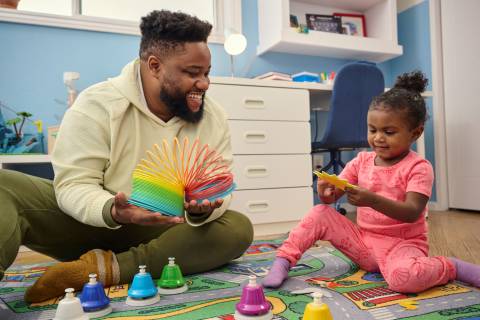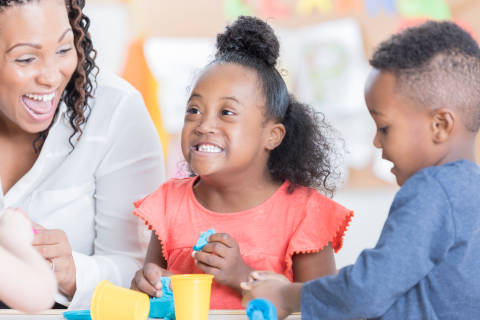Helping children develop language and communication skills early on is one of the most important ways caregivers can give their children a stronger start in life. California parents and caregivers of children who are deaf or hard of hearing can access a wealth of support and resources to help their children thrive.

An estimated 90%–95% of deaf or hard-of-hearing (DHH) children are born to hearing parents. We met with Dr. Julie Rems-Smario to learn more about how parents and caregivers of DHH children can help their children develop early language and communication skills and connect with the rich culture of the deaf community.
Dr. Rems-Smario, an experienced educator and advocate, specializes in deaf education and language rights for DHH children. She is currently an Education Programs Consultant of the Deaf Education Unit, a program of the State Special Schools and Services Division, conducting consultations for Early Start, Early Childhood Education, and the K-12 program for Deaf learners. As the co-coordinator of the California Early Hearing Detection and Intervention program, LEAD-K Family Services, she has dedicated her life to creating accessible language-rich learning environments.
Why are early language development and communication skills so important for children?
Children's language and communication skills begin to develop from birth as they actively absorb the gestures, facial expressions, and sounds around them.
“Hearing babies are ready for language right after they are born and have access to it. For deaf babies born to hearing parents, it is important to immediately start giving the support needed to make language accessible. Early language acquisition and development is crucial for deaf babies from the get-go," Dr. Rems-Smario explains.
Early access to language supports the growth and development of important brain structures that help with learning, memory, and other functions. Gaining language skills also enables children to express and understand emotions, build relationships with peers and caregivers, and develop important social skills for future success.
Language skills also contribute to early reading development, which is a key to success in school and beyond. Dr. Rems-Smario says that an important goal with early language exposure is to make sure children are ready for reading and writing when they get to kindergarten.
What happens when children aren’t exposed to early language development and communication skills?
When children aren’t exposed to language development and communication early on, it can negatively impact them throughout their lives and increase their risk of adverse childhood experiences (ACEs) and toxic stress.
Dr. Rems-Smario breaks down the trauma that deaf or hard-of-hearing children might experience into three crucial areas: family and school, friends and peers, and identity development. Without proper language exposure, DHH children may experience the following:
Poor family communication: When families don’t understand the early language development needs of their DHH child, the child may be left out of the flow of conversation at family gatherings. This is called "Dinner Table Syndrome," and it can lead to feelings of isolation, depression, and anxiety.
Challenges in building friendships with peers: Due to language barriers, DHH children might have a hard time building and maintaining friendships. This can lead to feelings of isolation and low self-esteem.
Difficulty with social norms, work skills, and living independently: These challenges can occur when children aren’t exposed to early language development and communication skills. Without language, DHH children may struggle to stand up for themselves, a skill that’s important for success in school, college, work, and more.
The good news is, with support, children who are deaf or hard of hearing can gain the essential early language development and communication skills they need to thrive.
What support do parents and caregivers receive in California to help children who are deaf or hard of hearing with early language development and communication skills?
Today, caregivers of deaf children in California have access to resources and support starting from the moment their child is born. When a child is born in a hospital, they immediately get early screening tests to identify any hearing challenges.
When a child is identified as deaf or hard of hearing through these screenings, the following steps typically take place to support the child and their family:
Notification and referral: The hospital informs the caregivers about the results of the screening and refers the child for a thorough audiological evaluation, or more in-depth hearing tests. A hearing expert, or audiologist, then refers the family to the California Early Hearing Detection and Intervention (EHDI) program called LEAD-K Family Services. LEAD-K Family Services connects the family to their Early Start Program and provides parent mentors to help families understand the referral process to the Early Start Program.
Diagnostic evaluation: The audiologist conducts a comprehensive evaluation to confirm the hearing level, determine how severe it is, and identify possible causes. This information is crucial for selecting appropriate interventions and accommodations.
Individualized Family Service Plan (IFSP): After connecting with the Early Start Program, the family, early intervention professionals, and service providers create an IFSP that addresses the specific needs of the child and their family. The IFSP outlines the early intervention services, goals, and strategies to support the child's development and the family's well-being.
Access to language development resources: The child’s Early Start teacher will work with the families of the DDH child to share important information about language milestones. SB 210 is a California state law that requires Early Start programs to give a full list of language milestones from age 0 to 5 in ASL and English, as well as the language spoken at home. The goal is for each DHH child to gain a strong foundation in at least one language by age 5 for kindergarten readiness. If the child is not meeting age-based language milestones, the family and teacher will create a new language plan as part of the child’s language goals. As California EHDI co-coordinator, LEAD-K Family Services, Dr. Rems-Smario underscores the importance of encouraging multilingualism for children, giving them many different language opportunities including ASL, English, and any other languages used in the home. A fun fact: California is the only state with deaf professionals leading as state EHDI co-coordinators!
Provision of support services: The services outlined in the IFSP are provided, which can include sign language and spoken language interventions, speech and language therapy, auditory training, ASL classes for families, deaf coach services, speech and auditory training, and any other necessary training.
Connection to the deaf community: Many programs are available to help children and caregivers meet with deaf mentors, coaches, and peer groups to develop a support network and immerse themselves in the rich culture of the deaf community.
Regular monitoring and review: The child's progress and the effectiveness of the interventions are regularly monitored, with the IFSP being continuously updated based on the child's growth and the family's changing needs. Language development is monitored using SB 210 language milestones and Desired Results Developmental Profile (DRDP) assessment in the language domain. DRDP is a guide that helps track a child's growth from infancy to kindergarten age. Teachers and parents use it to understand a child's progress and plan activities that help them learn better.
Transition to school: The IFSP team will continue to use the SB 210 language milestones until the child turns 5 to make sure they are ready for kindergarten. The IFSP team works with the family to develop a transition plan to move from early intervention services to school-based services.
Through these steps, the DHH child and family are provided with customized support and resources to promote language development and communication skills, which helps ensure the child's readiness for kindergarten.
In addition to early language intervention, how can caregivers support their DHH children?
Dr. Rems-Smario underscores the importance of connecting with the deaf community and creating opportunities for children to meet with deaf mentors, coaches, professionals, and peers. Families are encouraged to participate in the annual Love and Literacy event hosted by LEAD-K Family Services in seven different regions of California: Sacramento, the Bay Area, Fresno, Los Angeles, Orange County, Riverside, and San Diego. This event offers families and DHH children the opportunity to enjoy deaf storytellers, receive complimentary books, and socialize with other children who are deaf. The event is held every year in early March.
"It's important for families to meet with the deaf community to see what possibilities are available for their child," Dr. Rems-Smario explains. She adds, “Research shows that hearing parents wish they met deaf adults before their child is 3 months old.” Families can participate in local support groups and events, meet other families with deaf children, and involve children in deaf-friendly activities.
It’s also incredibly beneficial for the entire family to learn ASL. Introducing ASL vocabulary and concepts to caregivers and hearing children in the family can help bridge communication gaps and create an inclusive environment for the child who is deaf or hard of hearing. Families can even turn learning ASL into a fun game by trying activities like ASL charades, memory card games with ASL signs, or teaching children to sign their favorite nursery rhymes and songs. Because learning ASL at a young age enhances brain development and helps children communicate at a younger age, all children benefit from learning sign language.
Dr. Rems-Smario also points out that caregivers can make simple changes to ensure their DHH children feel included. For example, when reading picture books together, focus on turning the body so the child can watch the pictures and the reader’s facial expressions. Eye contact is also important to develop joint glance. Also known as "joint attention" or "shared gaze," joint glance is when two people look at the same thing at the same time. It's an important skill for communication and understanding what others are focused on or interested in. These cues will help them follow the story!
Parents and caregivers can help their DHH children thrive by promoting early language development, connecting with the deaf community, and creating inclusive and accessible environments.
Meet Dr. Julie Rems-Smario
Dr. Julie Rems-Smario is a dedicated educator, advocate, and leader in the area of deaf education and language rights for deaf and hard-of-hearing children. Holding a Doctorate in Educational Leadership, she has over two decades of experience fostering inclusive, accessible, quality learning environments for deaf students.
She currently works as an Education Programs Consultant for the Deaf Education Unit, a program of the State Special Schools and Services Division, where she is responsible for SB 210 and Early Start consultation for Early Start, Early Childhood Education, and K-12 deaf learners.
She is also the co-coordinator at LEAD-K, a statewide program run by NorCal Services for the Deaf based in California. Dr. Rems-Smario is the co-founder of CoFusion Group, a nonprofit that focuses on social justice work. As the co-founder and former executive director of DeafHope, she actively raises awareness and advocates against domestic and sexual violence in the deaf community. Dr. Rems-Smario has previously worked as a language specialist and teacher and as the education programs assistant of the CDE Deaf education unit.
Dr. Rems-Smario's passion and expertise enable her to be an effective champion for the rights and opportunities of DHH children.






